论翻译中词性转换
- 格式:doc
- 大小:72.50 KB
- 文档页数:9
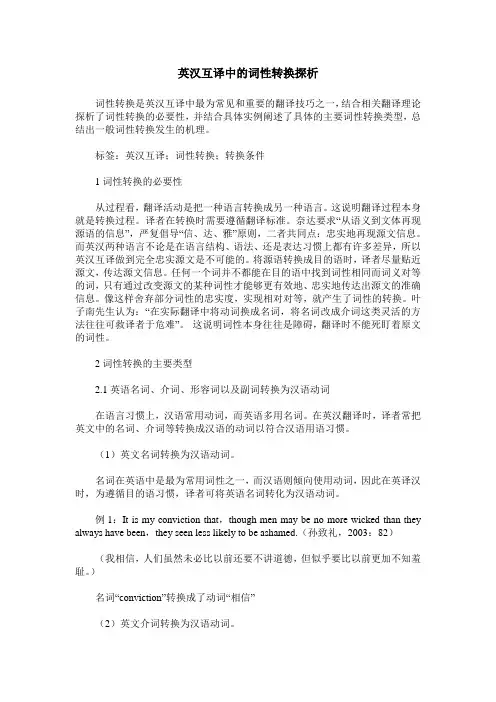
英汉互译中的词性转换探析词性转换是英汉互译中最为常见和重要的翻译技巧之一,结合相关翻译理论探析了词性转换的必要性,并结合具体实例阐述了具体的主要词性转换类型,总结出一般词性转换发生的机理。
标签:英汉互译;词性转换;转换条件1词性转换的必要性从过程看,翻译活动是把一种语言转换成另一种语言。
这说明翻译过程本身就是转换过程。
译者在转换时需要遵循翻译标准。
奈达要求“从语义到文体再现源语的信息”,严复倡导“信、达、雅”原则,二者共同点:忠实地再现源文信息。
而英汉两种语言不论是在语言结构、语法、还是表达习惯上都有许多差异,所以英汉互译做到完全忠实源文是不可能的。
将源语转换成目的语时,译者尽量贴近源文,传达源文信息。
任何一个词并不都能在目的语中找到词性相同而词义对等的词,只有通过改变源文的某种词性才能够更有效地、忠实地传达出源文的准确信息。
像这样舍弃部分词性的忠实度,实现相对对等,就产生了词性的转换。
叶子南先生认为:“在实际翻译中将动词换成名词,将名词改成介词这类灵活的方法往往可救译者于危难”。
这说明词性本身往往是障碍,翻译时不能死盯着原文的词性。
2词性转换的主要类型2.1英语名词、介词、形容词以及副词转换为汉语动词在语言习惯上,汉语常用动词,而英语多用名词。
在英汉翻译时,译者常把英文中的名词、介词等转换成汉语的动词以符合汉语用语习惯。
(1)英文名词转换为汉语动词。
名词在英语中是最为常用词性之一,而汉语则倾向使用动词,因此在英译汉时,为遵循目的语习惯,译者可将英语名词转化为汉语动词。
例1:It is my conviction that,though men may be no more wicked than they always have been,they seen less likely to be ashamed.(孙致礼,2003:82)(我相信,人们虽然未必比以前还要不讲道德,但似乎要比以前更加不知羞耻。
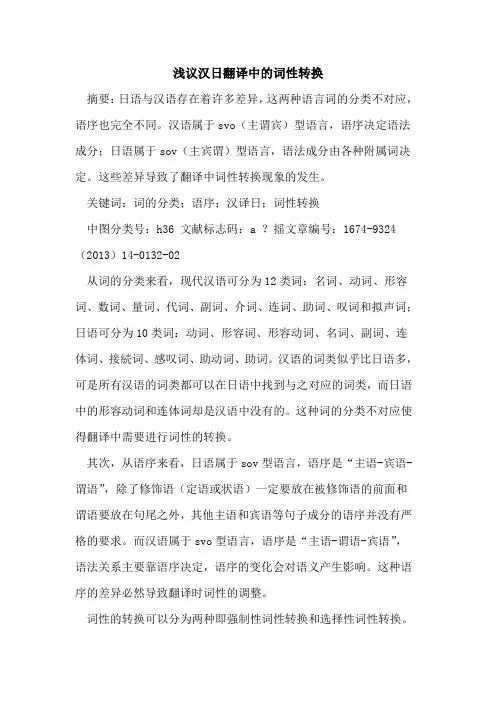
浅议汉日翻译中的词性转换摘要:日语与汉语存在着许多差异,这两种语言词的分类不对应,语序也完全不同。
汉语属于svo(主谓宾)型语言,语序决定语法成分;日语属于sov(主宾谓)型语言,语法成分由各种附属词决定。
这些差异导致了翻译中词性转换现象的发生。
关键词:词的分类;语序;汉译日;词性转换中图分类号:h36 文献标志码:a ?摇文章编号:1674-9324(2013)14-0132-02从词的分类来看,现代汉语可分为12类词:名词、动词、形容词、数词、量词、代词、副词、介词、连词、助词、叹词和拟声词;日语可分为10类词:动词、形容词、形容动词、名词、副词、连体词、接続词、感叹词、助动词、助词。
汉语的词类似乎比日语多,可是所有汉语的词类都可以在日语中找到与之对应的词类,而日语中的形容动词和连体词却是汉语中没有的。
这种词的分类不对应使得翻译中需要进行词性的转换。
其次,从语序来看,日语属于sov型语言,语序是“主语-宾语-谓语”,除了修饰语(定语或状语)一定要放在被修饰语的前面和谓语要放在句尾之外,其他主语和宾语等句子成分的语序并没有严格的要求。
而汉语属于svo型语言,语序是“主语-谓语-宾语”,语法关系主要靠语序决定,语序的变化会对语义产生影响。
这种语序的差异必然导致翻译时词性的调整。
词性的转换可以分为两种即强制性词性转换和选择性词性转换。
强制性词性转换是指在一种语言中属于这类词性,而翻译成另一种语言时则会变成另一类词性。
例如日语「飢える、太る、尖る」是动词,汉译后需转换成形容词“饿的,胖的,尖的”。
这种在翻译时必然要发生的词性转换就是强制性词性转换。
选择性词性转换是指在翻译时既可译成与原来一样的词性,也可译成另一类词性。
例如日语「資源の蓾約、消費の減少、品質の向上」是名词性表现形式,汉译时既可译成名词性词组“资源的节约,消费的减少,质量的提高”,又可译成动词性词组“节约资源,减少消费,提高质量”,这种转换词性的译法即为选择性词性转换。
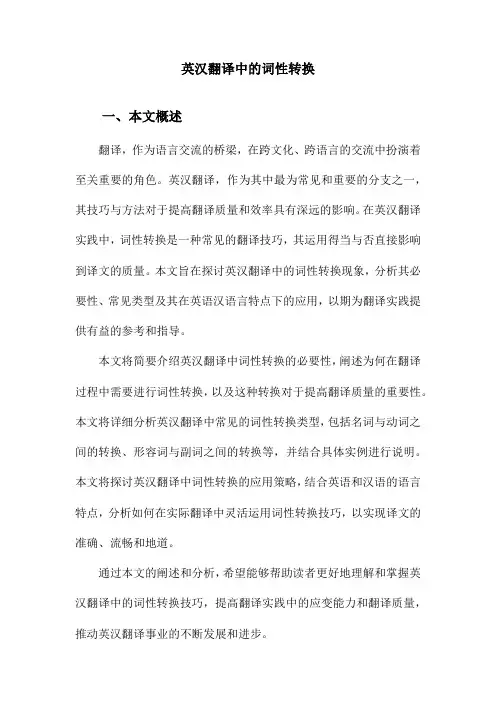
英汉翻译中的词性转换一、本文概述翻译,作为语言交流的桥梁,在跨文化、跨语言的交流中扮演着至关重要的角色。
英汉翻译,作为其中最为常见和重要的分支之一,其技巧与方法对于提高翻译质量和效率具有深远的影响。
在英汉翻译实践中,词性转换是一种常见的翻译技巧,其运用得当与否直接影响到译文的质量。
本文旨在探讨英汉翻译中的词性转换现象,分析其必要性、常见类型及其在英语汉语言特点下的应用,以期为翻译实践提供有益的参考和指导。
本文将简要介绍英汉翻译中词性转换的必要性,阐述为何在翻译过程中需要进行词性转换,以及这种转换对于提高翻译质量的重要性。
本文将详细分析英汉翻译中常见的词性转换类型,包括名词与动词之间的转换、形容词与副词之间的转换等,并结合具体实例进行说明。
本文将探讨英汉翻译中词性转换的应用策略,结合英语和汉语的语言特点,分析如何在实际翻译中灵活运用词性转换技巧,以实现译文的准确、流畅和地道。
通过本文的阐述和分析,希望能够帮助读者更好地理解和掌握英汉翻译中的词性转换技巧,提高翻译实践中的应变能力和翻译质量,推动英汉翻译事业的不断发展和进步。
二、词性转换的基本概念词性转换,即在翻译过程中,将源语言中的某一词类转换为目标语言中的另一词类,而不改变其原意,是英汉翻译中一种常见的翻译技巧。
这种技巧的运用,旨在使译文更加地道、流畅,更符合目标语言的表达习惯。
在英汉翻译中,由于两种语言的语法结构和表达习惯存在差异,因此,翻译时常常需要进行词性转换。
例如,英语中的动词在汉语中可能需要转换为名词、形容词或副词;同样,汉语中的名词在英语中也可能需要转换为动词、形容词或副词。
这种转换并不是随意的,而是需要基于对源语言和目标语言的理解和掌握,以及对翻译原则的遵循。
词性转换的翻译技巧可以分为两类:一是完全转换,即源语言中的某一词类完全转换为目标语言中的另一词类;二是部分转换,即源语言中的某一词类在转换为目标语言时,仍然保留部分原词类的特性。
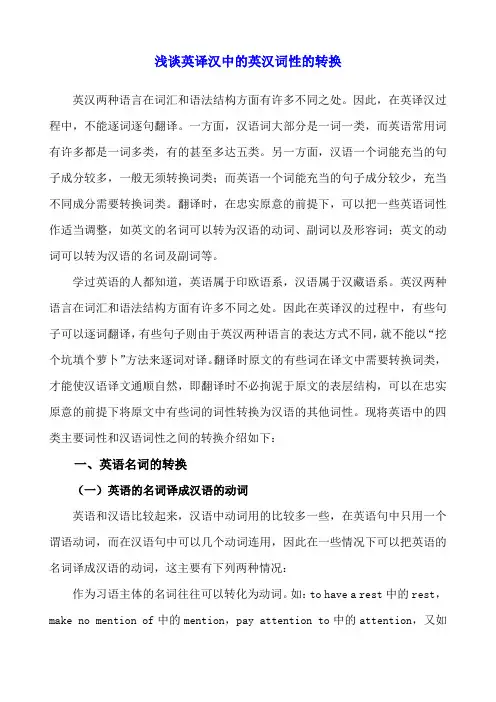
浅谈英译汉中的英汉词性的转换英汉两种语言在词汇和语法结构方面有许多不同之处。
因此,在英译汉过程中,不能逐词逐句翻译。
一方面,汉语词大部分是一词一类,而英语常用词有许多都是一词多类,有的甚至多达五类。
另一方面,汉语一个词能充当的句子成分较多,一般无须转换词类;而英语一个词能充当的句子成分较少,充当不同成分需要转换词类。
翻译时,在忠实原意的前提下,可以把一些英语词性作适当调整,如英文的名词可以转为汉语的动词、副词以及形容词;英文的动词可以转为汉语的名词及副词等。
学过英语的人都知道,英语属于印欧语系,汉语属于汉藏语系。
英汉两种语言在词汇和语法结构方面有许多不同之处。
因此在英译汉的过程中,有些句子可以逐词翻译,有些句子则由于英汉两种语言的表达方式不同,就不能以“挖个坑填个萝卜”方法来逐词对译。
翻译时原文的有些词在译文中需要转换词类,才能使汉语译文通顺自然,即翻译时不必拘泥于原文的表层结构,可以在忠实原意的前提下将原文中有些词的词性转换为汉语的其他词性。
现将英语中的四类主要词性和汉语词性之间的转换介绍如下:一、英语名词的转换(一)英语的名词译成汉语的动词英语和汉语比较起来,汉语中动词用的比较多一些,在英语句中只用一个谓语动词,而在汉语句中可以几个动词连用,因此在一些情况下可以把英语的名词译成汉语的动词,这主要有下列两种情况:作为习语主体的名词往往可以转化为动词。
如:to have a rest中的rest,make no mention of中的mention,pay attention to中的attention,又如take care of中的care这几个词都是短语中的中心词,这些词虽然是名词,但几个短语表达的都是一种动作,再者,rest,mention和care本身既可作名词又可作动词,因此这样有动作意味的名词可以翻译成汉语的动词。
因此这几个英语短语中的名词可以翻译成汉语动词休息、提及、注意和照顾。
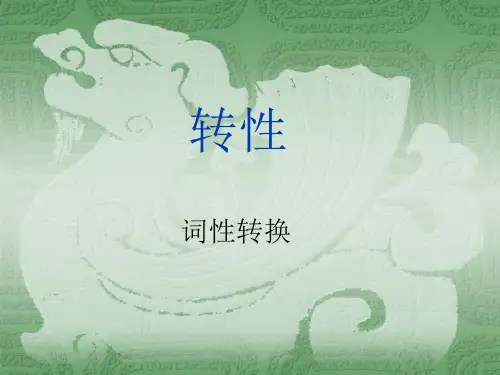

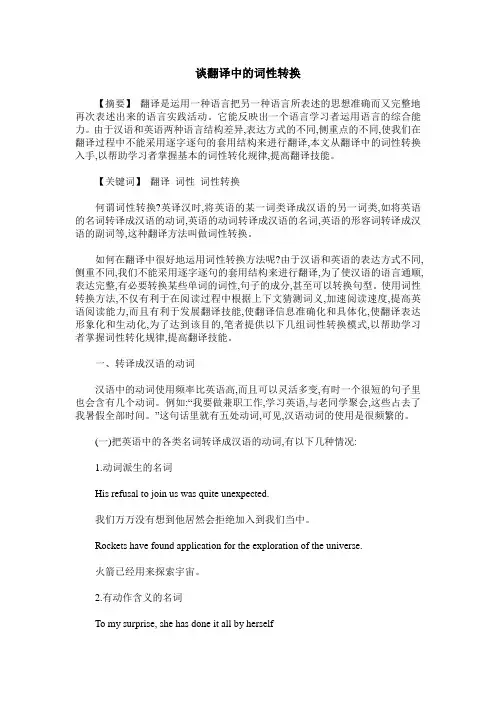
谈翻译中的词性转换【摘要】翻译是运用一种语言把另一种语言所表述的思想准确而又完整地再次表述出来的语言实践活动。
它能反映出一个语言学习者运用语言的综合能力。
由于汉语和英语两种语言结构差异,表达方式的不同,侧重点的不同,使我们在翻译过程中不能采用逐字逐句的套用结构来进行翻译,本文从翻译中的词性转换入手,以帮助学习者掌握基本的词性转化规律,提高翻译技能。
【关键词】翻译词性词性转换何谓词性转换?英译汉时,将英语的某一词类译成汉语的另一词类,如将英语的名词转译成汉语的动词,英语的动词转译成汉语的名词,英语的形容词转译成汉语的副词等,这种翻译方法叫做词性转换。
如何在翻译中很好地运用词性转换方法呢?由于汉语和英语的表达方式不同,侧重不同,我们不能采用逐字逐句的套用结构来进行翻译,为了使汉语的语言通顺,表达完整,有必要转换某些单词的词性,句子的成分,甚至可以转换句型。
使用词性转换方法,不仅有利于在阅读过程中根据上下文猜测词义,加速阅读速度,提高英语阅读能力,而且有利于发展翻译技能,使翻译信息准确化和具体化,使翻译表达形象化和生动化,为了达到该目的,笔者提供以下几组词性转换模式,以帮助学习者掌握词性转化规律,提高翻译技能。
一、转译成汉语的动词汉语中的动词使用频率比英语高,而且可以灵活多变,有时一个很短的句子里也会含有几个动词。
例如:“我要做兼职工作,学习英语,与老同学聚会,这些占去了我暑假全部时间。
”这句话里就有五处动词,可见,汉语动词的使用是很频繁的。
(一)把英语中的各类名词转译成汉语的动词,有以下几种情况:1.动词派生的名词His refusal to join us was quite unexpected.我们万万没有想到他居然会拒绝加入到我们当中。
Rockets have found application for the exploration of the universe.火箭已经用来探索宇宙。
2.有动作含义的名词To my surprise, she has done it all by herself令我吃惊的是,她独自完成了任务。
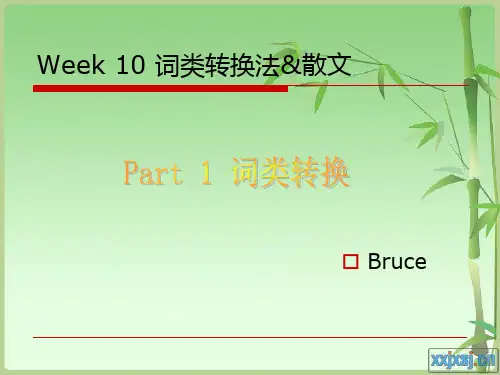
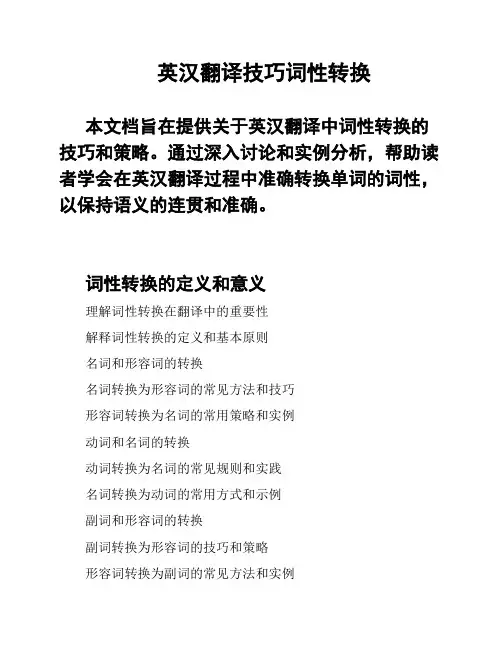
英汉翻译技巧词性转换本文档旨在提供关于英汉翻译中词性转换的技巧和策略。
通过深入讨论和实例分析,帮助读者学会在英汉翻译过程中准确转换单词的词性,以保持语义的连贯和准确。
词性转换的定义和意义理解词性转换在翻译中的重要性解释词性转换的定义和基本原则名词和形容词的转换名词转换为形容词的常见方法和技巧形容词转换为名词的常用策略和实例动词和名词的转换动词转换为名词的常见规则和实践名词转换为动词的常用方式和示例副词和形容词的转换副词转换为形容词的技巧和策略形容词转换为副词的常见方法和实例例句分析与实践提供一些实际例句进行分析和转换实践深入探讨例句中词性转换的技巧和注意事项总结与扩展对本文档中所涉及的词性转换技巧进行总结和回顾提供更多补充资料和延伸阅读资源请注意,本文档的目标是提供简洁明了的指导,避免复杂的法律问题并独立进行决策。
导言请注意,本文档的目标是提供简洁明了的指导,避免复杂的法律问题并独立进行决策。
导言英汉翻译技巧词性转换》是一本重要的翻译技巧手册,它涉及到了词性转换在英汉翻译中的应用。
词性转换指的是将一个词的词性从一种转换为另一种,以达到更恰当地表达原文含义的目的。
英汉翻译技巧词性转换》是一本重要的翻译技巧手册,它涉及到了词性转换在英汉翻译中的应用。
词性转换指的是将一个词的词性从一种转换为另一种,以达到更恰当地表达原文含义的目的。
词性转换在翻译过程中具有广泛的应用领域。
它可以帮助翻译者解决一些句子难以准确翻译的问题,提高翻译质量和可读性。
无论在文学作品、商务文件还是学术论文等领域,词性转换都起到了不可忽视的作用。
在《英汉翻译技巧词性转换》中,我们将介绍一些简单且没有法律复杂性的策略和技巧,旨在帮助翻译者更好地掌握词性转换的方法。
我们鼓励翻译者发挥自己的优势,并遵循简洁明了的原则,不引用无法确认的内容。
无论是英汉互译还是汉译英,词性转换都是一个关键技巧。
通过研究和掌握《英汉翻译技巧词性转换》,您将能够更好地处理词性转换的问题,提升翻译水平。
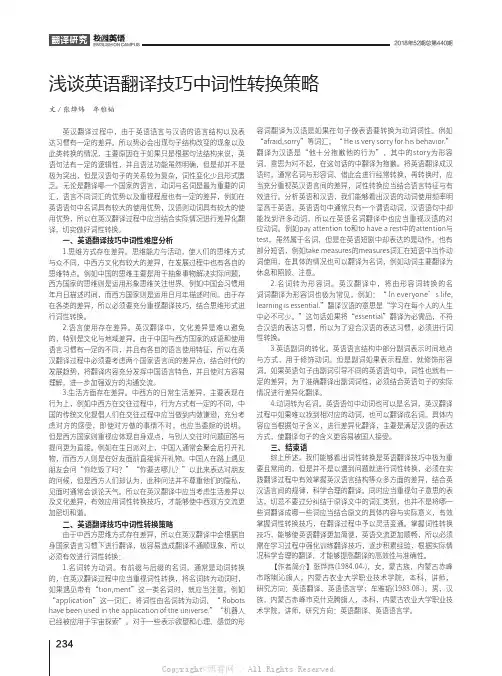
2342018年52期总第440期ENGLISH ON CAMPUS浅谈英语翻译技巧中词性转换策略文/张烨炜 牟雅韬容词翻译为汉语是如果在句子做表语要转换为动词词性。
例如“afraid,sorry”等词汇,“ He is very sorry for his behavior.”翻译为汉语是“他十分抱歉他的行为”,其中的story为形容词,意思为对不起,在这句话的中翻译为抱歉。
将英语翻译成汉语时,通常名词与形容词、借此会进行经常转换,再转换时,应当充分重视英汉语言间的差异,词性转换应当结合语言特征与有效进行。
分析英语和汉语,我们能够看出汉语的动词使用频率明显高于英语。
英语语句中通常只有一个谓语动词,汉语语句中却能找到许多动词,所以在英语名词翻译中也应当重视汉语的对应动词。
例如pay attention to和to have a rest中的attention与test,虽然属于名词,但是在英语短剧中却表达的是动作。
也有部分短语,例如take measures的measures词汇在短语中当作动词使用,在具体的情况也可以翻译为名词,例如动词主要翻译为休息和照顾、注意。
2.名词转为形容词。
英汉翻译中,将由形容词转换的名词词翻译为形容词也极为常见。
例如:“ In everyone’s life, learning is essential.”翻译汉语的意思是“学习在每个人的人生中必不可少。
”这句话如果将“essential”翻译为必需品,不符合汉语的表达习惯,所以为了迎合汉语的表达习惯,必须进行词性转换。
3.英语副词的转化。
英语语言结构中部分副词表示时间地点与方式,用于修饰动词。
但是副词如果表示程度,就修饰形容词。
如果英语句子由副词引导不同的英语语句中,词性也就有一定的差异,为了准确翻译出副词词性,必须结合英语句子的实际情况进行差异化翻译。
4.动词转为名词。
英语语句中动词也可以是名词,英汉翻译过程中如果难以找到相对应的动词,也可以翻译成名词。

英汉翻译中的词性转换作者:尹春晨来源:《校园英语·上旬》2018年第12期【摘要】英汉造句方式上的差异必然也导致了词类使用频率的不同。
主要体现在连接手段的区别和词性的不同。
英语多使用介词,代词,连接词等连接句子,而汉语则更多的依靠词序,逻辑顺序来连接句子。
英语多用名词和介词等来表达,汉语则多用动词等来表达,因此在翻译中必须作大量的词性转换工作。
【关键词】英汉连接手段的区别和词性的不同;词性转换【作者简介】尹春晨,上海政法学院外国语学院。
英汉造句方式上的差异必然也导致了词类使用频率的不同。
虽然形合句和意合句并存于英汉两种语言之中,但所占的比重却相差悬殊。
具体的说,英语强调形式上的严整,词与词,小句与小句之间的关系往往都借助于语言形式加以表达。
英语句子中连接手段不仅形式多样,种类繁多,而且使用频率颇高。
英语的连接手段包括使用关系词,连接词,介词,代词以及有关的形态变化形式等。
相形之下,汉语的形式连接手段明显要少,汉语既没有词形变化,也没有英语中频繁使用的关系词,连接词,介词,连词等虚词不仅数量较少,而且使用得远不如英语中的类似词那样普遍。
汉语更多地依靠词序注重逻辑顺序,强调意义连贯。
英汉语的一个显著差别就是:英语句子中,名词与介词占优势;汉语句子中,动词占优势。
由于英语句子中的谓语动词受动词形态变化的约束,句子中只能有一个谓语动词,它是英语句子的轴心和核心,然后要借用名词来表达。
而名词和名词之间的联系却要借助介词来串通,所以英语句子名词和介词占优势。
要理解和掌握英语,只要抓住谓语动词就抓住了英语句子的灵魂。
在翻译时,对介词要特别注意。
因为英语句子的扩展,准确意义的表达,往往是通过介词来实现的。
例如:Inadequate training for farmers and the low productivity of many farms place the majority of country dwellers in a disadvantageous position in their own countries.(农民缺乏训练,许多农场生产率很低,这就使得大多数农民处于贫穷的困境。
浅析英汉翻译中的词性转换作者:武重阳来源:《现代经济信息》2016年第08期摘要:英汉翻译中的词性转换问题,表现在两种语言的语言结构差异性上。
词性转换是翻译的重要方法,在词性及语义规范上来突出结构合理、逻辑严密,尤其是在英语中的名词、形容词、介词、副词等转换中,要避免词不达意,还要避免形式上的过于对等而带来的翻译晦涩。
为此,本文着重对词性转换及英汉翻译中的具体方法进行阐述,并通过实例拉力进行转译,便于提升译文质量。
关键词:英汉翻译;词性转换;实例应用中图分类号:H315.9 文献识别码:A 文章编号:1001-828X(2016)08-000-02翻译理论家费道罗夫在探讨翻译的目标时提出“翻译要突出对原文的表达,要从文体、语言、词性等方面做到‘等值’”。
英汉翻译基于不同的语言结构体系,在进行翻译实践中,如何把握词性的转换文体,一直是翻译教学的重要内容。
英语源自印欧语系,而汉语属于汉藏语系,两者在语言结构上具有较大差异性。
因此,无论是在英译汉,还是汉译英,都需要从语言形式上,把握原文的意指,并从再现原文信息上进行准确翻译。
因此,词性作为英汉翻译实践中的重要内容,其转换的合理性、准确性关系到整个翻译实践的成败。
因此,着力从英汉翻译中,就其中突出的词性转换条件、转换技巧及方法进行研究,重点对在英汉翻译中的词性变化来进行归纳,帮助我们从翻译实践中提升译文质量,更准确的还原和洞悉原文的信息。
一、翻译中的词性转换研究翻译是跨语言的文化交流,对于翻译中的词性转换问题,尤金·奈达提出的“功能对等”理论最具代表性。
尤金·奈达从翻译实践中通过导入分类系统,尤其是从语言学视角来挖掘翻译的本质,强调在翻译过程中,要把握动态的对等。
如在翻译中,需要用最恰当的语言来再现源语的语义及文体特征。
对于语言学本身,其包含的内容较广,仅词性只是语言学中的一个分支概念。
除此之外,语言学中的语音、词、句、段等,在翻译过程中都需要给予综合考虑。
翻译中词性转换的技巧一 .研究课题的目的和意义汉语与英语在词法和语言结构方面都存在着很大的差异。
因此,为了达到既忠实于原文又准确流畅的目的,翻译时应掌握一些必要的翻译技巧,词性转换即是其中之一。
词性是词在语法意义上的性别, 它表示词所属的类别, 是词的表述功能的外在标记。
词性转换是指翻译时为了正确而顺畅地表达原文内容而改变词的属性,即改变词性。
在汉译英语句子时,使每一个英语单词都有一个与之词义和词性均相同的汉语词相对应是几乎不可能的。
若一定要用词性相同的汉语词来译出英语原旬,那么,汉语译文常常会因不符合汉语的语言习惯及规范而读起来非常别扭,甚至艰涩难懂。
词性转换在汉译英翻译中是一项技巧,其关键在于源语与目的与之间的词汇和句子结构差异较大。
本文旨在探索在翻译的过程中如何更好地在翻译中使用词性转换的技巧,从而帮助大家逐步提高翻译能力和更加灵活运用词性转换这一翻译技巧。
使其翻译的句子准确通顺,将由于英汉差异而引起的语言机械转换,根据表达习惯进行适当调整和转换,使译文变得更加的妥帖、顺畅。
二.文献综述刘小芬,杨筱霞在《再谈英汉互译中的词性转换》提出然而,许多人认为,翻译最大的障碍应该是两种语言的不同词性的转换。
因为一种语言中的任何一个词并不总是能够在另一种语言中找到词性相同而词义又完全一样的词。
只有通过改变原文的某种词性才能够更有效地传达出原文的准确意思。
这种把一种语言中的某种词性转换成另一种语言的另一种词性来表达的翻译方法就是词性的转换。
谢捷在《英语名动转用中不同种类名词的转用几率探析》中提出“名词转化动词是基于原型名词的语义特征和所属语义种类确立其词义的,语言学家提出了多种转类动词的划分。
”陆俭明在《现代汉语语法研究教程(第三版)》中提到兼类词。
兼类词指“同一个概括词兼有两种词类特性的词,即指同音同义而词性不同的词”郑蕙在《论英汉翻译中的词性和句形转换》中提出“在英汉翻译过程中,因为汉、英两个民族不同的思维模式以及相关的社会背景环境和文化的不同给汉英翻译造成一定困难,所以有“语随境迁,语无定义”之说。
浅谈词性转换法在汉译英翻译中的应用作者:王晨来源:《陕西教育·高教版》2009年第02期[摘要]结合词性转换法的翻译技巧在汉英翻译中应用,以及对英汉两种语言的理解,达到翻译的“忠实与通顺”。
[关键词]词性转换法汉译英词性转译法是汉译英中常使用的翻译方法,指:根据汉语的规范表达方式进行词性转换。
比如,由于汉语多用动词,因此在做汉译英时,时常将汉语的动词译为英语中的名词、形容词、副词、介词短语等。
汉语的动词转化为英语中的名词当汉语中出现了至少两个或以上的动词,并且在这两个动词中有主次之分时,作为次动词的的汉语可以翻译为英语的名词。
次动词在汉语句子中通常充当主语、宾语、表语、定语等成分。
例如:例一:了解过去有助于了解现在,了解现在有助于了解未来。
分析:在本句中共出现了“了解”和“有助于”这两组动词。
首先分析一下这两个词,若同时将其翻译成动词,则不符合英语的语言习惯。
经过权衡,“了解过去”可将其翻译成主语来平衡句子结构,将“有助于”翻译成句子的谓语,这样翻译句子结构较清晰,层次合理,并能准确地表达原句的意思。
译文:An acquaintance of the past is helpful to the acquaintance of present, which is in turn helpful to the prediction of the future.例二:这些为东亚各国保持经济持续增长、发展经济合作创造了重要的前提条件。
分析:“保持增长、发展和创造”这三个词在汉语中同为动词。
经过分析,汉语中“为……创造条件”是句子中的主干,将其作为谓语,把“保持增长和发展”用作名词,翻译为宾语,这样较符合英语习惯说法。
译文:These have provided an important prerequisite for the sustained economic growth of East Asian countries and the development of their economic cooperation.汉语的动词转化为英语中的形容词汉语中出现表示知觉、感情、心理状态,以及表示长时间状态的动词时,按照英语的语言习惯,以上词汇通常在英文中以形容词性出现,在翻译成英文时就要将其转化为形容词。
0引言随着全球化的发展,全球经济、文化交流日渐频繁。
由于中西语言文化差异,翻译在全球的交流与学习中起着至关重要的作用。
何为翻译?简言之,即将一种语言转换为另一种语言。
尤金·奈达曾提出:“翻译就是在接受语中以最自然的方式重现原文中的信息,首先是意义,然后是风格。
”因此,准确且流畅的译文对译者而言并非易事,在翻译时掌握一定的翻译技巧非常必要。
词性转换是翻译中重要的技巧之一。
1词性与词性转换的定义词性是是一种语言中词的语法分类,是以语法特征(包括句法功能和形态变化)为主要依据、兼顾词汇意义对词进行划分的结果。
从组合和聚合关系来说,一个词类指在一种语言中,众多具有相同句法功能、能在同样的组合位置中出现的词,聚合在一起形成的范畴。
汉语有12种词性,而英语有10种词性。
很多人认为翻译中最大的阻碍是两种语言之间词性的转换,因为一种语言中的任何一个词不可能在另一种语言中总能找到对等的词,此时只有将源语中的词在目标语中改变词性,方能准确表达出源语所要表达的信息,这就是词性转换。
尤金·奈达曾提出词性转换的中心是动态对等。
之后,他将之改为“功能对等”,功能对等不仅仅是形式上的对等,更重要的是功能的对等。
因此词性转换即为使译文准确流畅,译者在翻译时总是将源语中的特定的词性转换为目标语中的另一词性。
2翻译中词性转换的原则(1)忠实原则。
一个好的翻译是这样一种翻译:把原作的优点完整地移入另一种语言,使得译入语国家的读者能够像源语读者一样明确领悟,强烈地感受原作那样,领悟和感受译作。
(泰特勒,1970)泰特勒认为,翻译原则的意义不需要解释。
在翻译中使用词类转换技巧必须遵循忠实原则。
词类转换的目的是使翻译像原文一样准确,忠实于原文。
它要求译者不仅要尊重原文的思想,而且要保持原文的风格。
然而在翻译实践中,并不是绝对忠实,而是相对忠实。
(2)通顺原则。
通顺即译文必须符合目的语的表达习惯,翻译要像原文一样生动、朴实。
On Transformation of Parts of Speech in TranslationI. IntroductionParts of speech are the core content of the traditional grammar according to which words are classified as follows: nouns, verbs, adjectives, adverbs, pronouns, prepositions, conjunctions, etc. Different languages have different standards to distinguish parts of speech. English belongs to the Indo-European language family, and parts of speech in it are categorized as word-order, lexical meaning and inflection changes. Nouns, verbs, adjectives and adverbs have complex systems of endings or vowel changes or both. For example, the form –ize, -en and –ify are used to denote the possessive case of verbs. But quite different from English, Chinese belongs to the Sino-Tibetan language family and parts of speech are divided based on sentence structure function.Apart from the above differences, another great one is that English is a kind of static language which tends to use more nouns, prepositional phrases, etc. While Chinese is a dynamic one in which verbs are often used. So, when we translate between these languages, we commonly use transformation of parts of speech to make the translation more standard and idiomatic. No one can say that the target language (TL) and the source language (SL) tex ts ―have the same meaning‖, because each one has its own meaning. Eugene A. Nida, a distinguished American theorist, reformed the traditional parts of speech and established a new system which has been applied into practice. For example,TL:她工作出色。
SL:1. She works excellently.2. Her excellent work3. the excellence of her work4. Her work is excellent.The different expressions indicate the same meaning. So the transformation of parts of speech is based on the premise that the target language must be faithful to theoriginal language. Correctly using of parts of speech conversion can make the translated version smoother and clearer. This thesis will study the importance of the transformation of parts of speech and problems concerning using this method and some countermeasures.II. Translation and Transformation of Parts of SpeechIt is hard to define translation as a science or an art, a skill or a taste. It is understood as a linguistic phenomenon, as an operation performed on languages. This operation is seen as a process of translating between source language and target language. Many dictionaries offer synonyms for translation such as interpretation, conversion, transformation, expressiveness, transference, which are followed by from one language into another. Other authorities make use of expressions such as ‗identical‘, ‗equivalent textual material‘, ‗similar‘, ‗comparable‘, etc. So translation may be defined as: ―the replacement of textual material in one language (SL) by equivalent material in another l anguage (TL)‖ (Schaffner 2). Roger Bell, a professor of linguistics, says that ―Translation is the expression in another, source language, preserving semantic and stylistic equivalences‖ (5). The two definitions both refer to ‗equivalent‘ which replicates the same situation as in the original, while using completely different wording. Again, we have a descriptive definition from Nida: Translating consists in reproducing in the receptor language the closest natural equivalent of the source language message, first in terms of meaning, and secondly in terms of style (12). To shift from one language to another is, by definition, to alter the forms. Unfortunately, languages are not this simple, and difficulties may also arise when there are no equivalent parts of speech. Each language has its own special structure. Word-for-word correspondences do not exist in the process of translation. The reasons are as follows:1. Words have more than one meaning;2. Many words are culture-bound and have no direct equivalents;3. Cultural orientations can render a direct translation nonsensical;4. A culture may not have the background and understanding to translateexperiences specific to other cultures. (Samovar 132)There are some examples which will be illustrated here. ―birds of a father‖ means ―一丘之貉‖; ―天生有福‖, when translated into English, it may be ―born with a silver spoon in one‘s mouth‖. The important point is that shifts and changes in the technique of translating do not occur at random. Rather, they are linked with different cultures and times. So, we are seeking to different methods of translating to get equivalence of high level.Translation aims primarily at reproducing the message. To do anything else is essentially false to one‘s task as a translator. But to repro duce the message one must make a good many adjustments as accuracy and economy. There are four kinds of adjustments.(1)Semantic adjustmentIn order to completely express the meaning of the original work, sometimes a literal translation is not advised. F or instance, ―The accounts were balanced‖. This indicates ―已结账了‖. If it is translated into ―账已被平衡了‖, nobody can understand it.(2)Word-order adjustmentIn the process of translation, the translator must pay more attention to the characteristics of langua ges. Here are some examples. ―the rate of interest‖ means ―利率‖; ―the unit of measurement‖ means ―计量单位‖. But these versions ―利息的比率‖ and ―计量的单位‖ do not comply with briefness and parataxis which are the features of Chinese.(3)Grammatical adjustmentThe transformation of parts of speech is often used as a method of grammatical adjustment in order to get a better version. For example, ―We are lovers of the world peace.‖ Means ―我们热爱世界和平‖ or ―我们是世界和平的热爱者‖. The former version would be much more idiomatic.(4)Literary-style adjustmentDifferent styles of writing have different requirements such as narration, argumentation, description and exposition, while there are formal and informal styles in the colloquial English. When doing translation, we should make the adjustment inaccordance with different styles. For example:(1)但是,照抄照搬别国的经验,别国的模式,从来就不能得到成功。